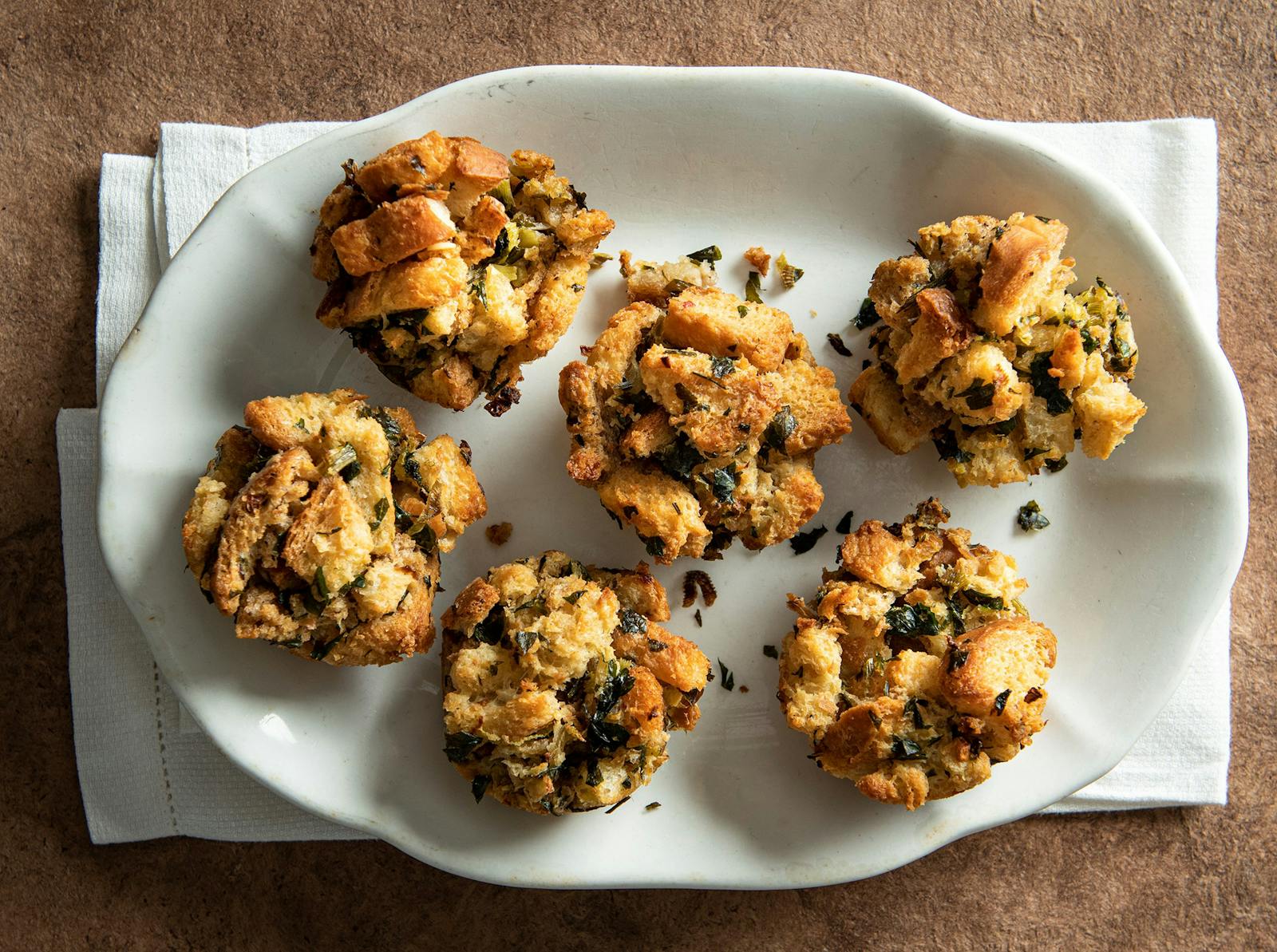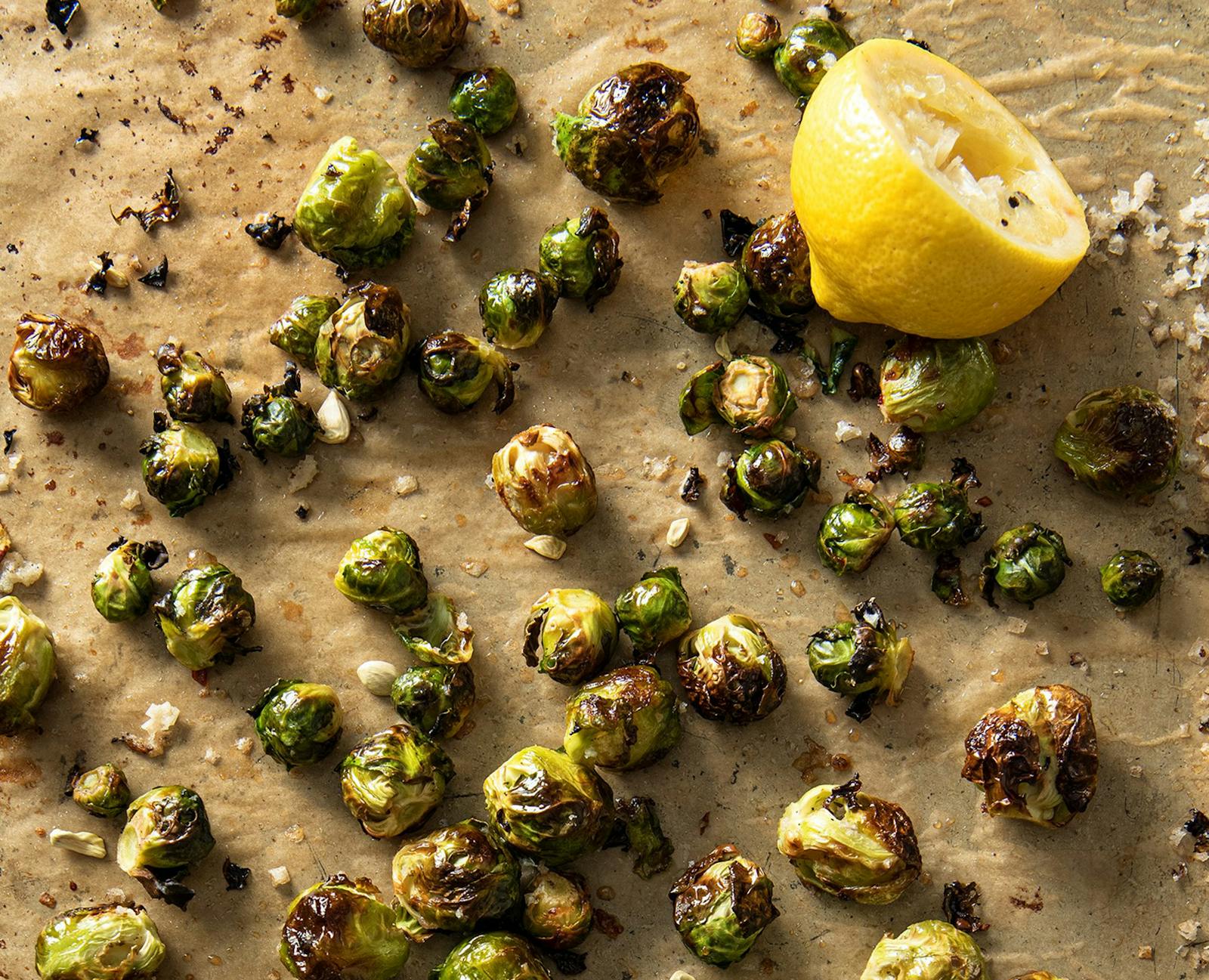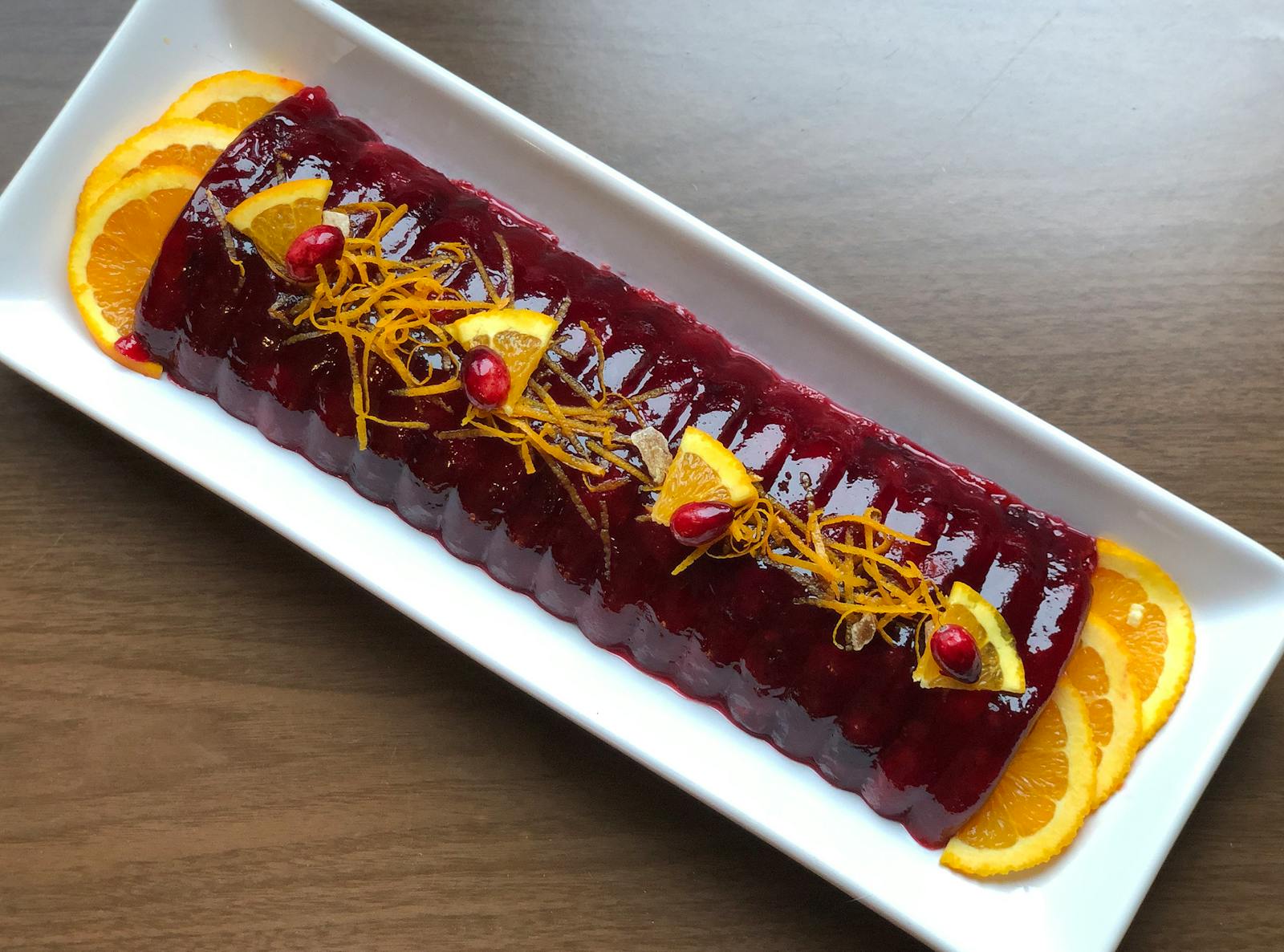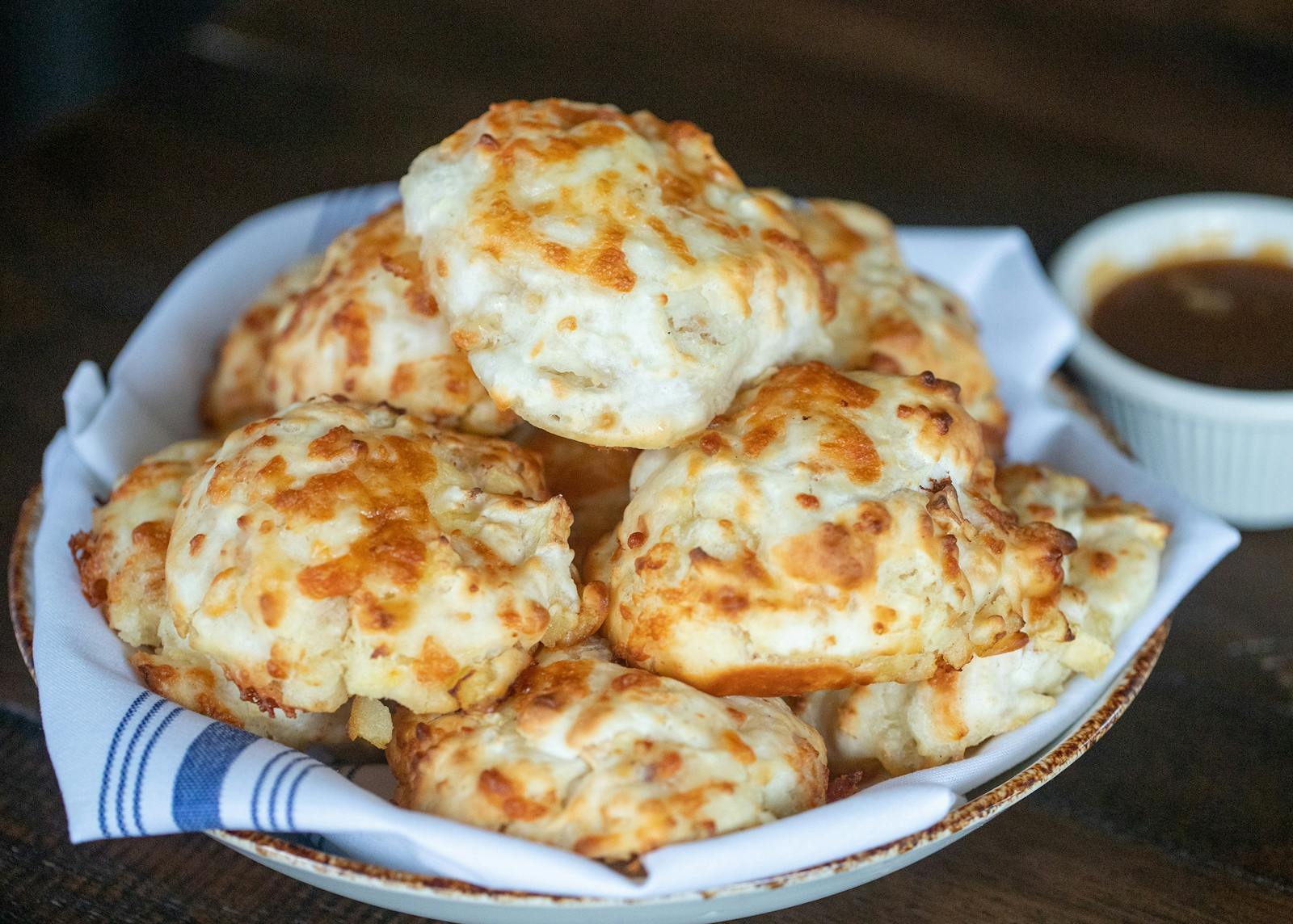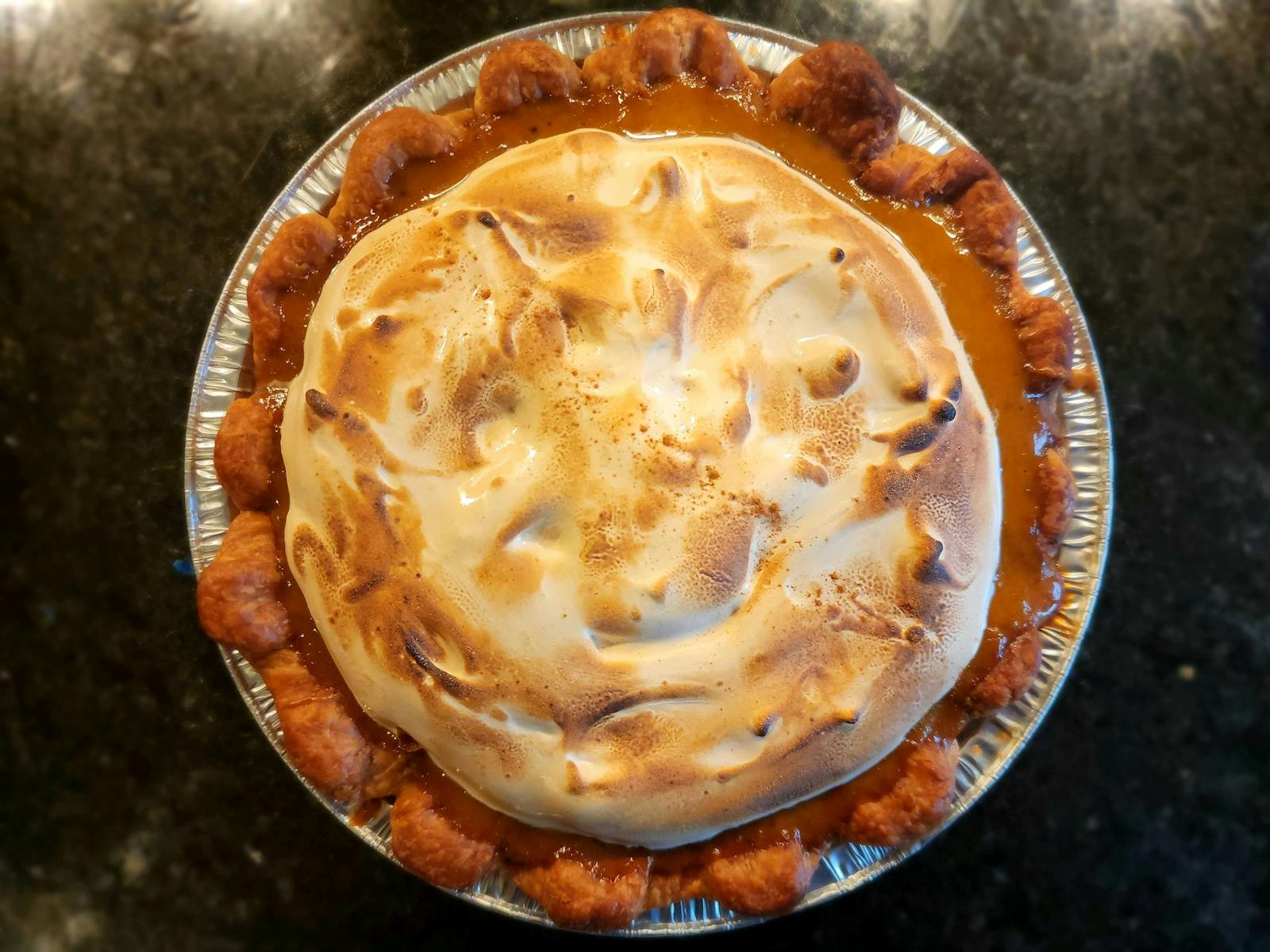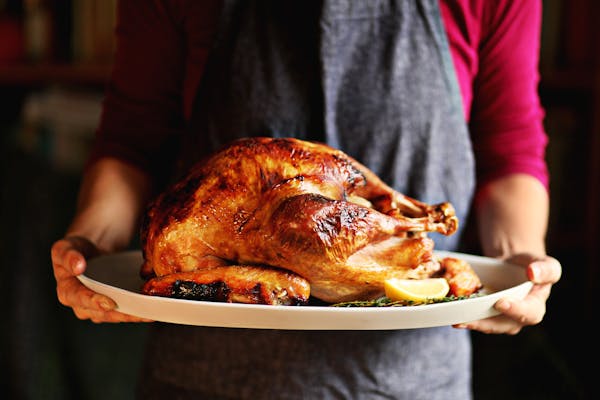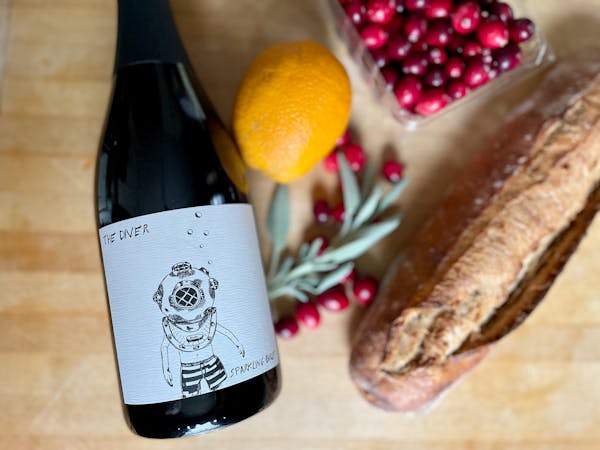Everyone has their favorites at the Thanksgiving table, and heaven help the cook who takes one of them away. A colleague summed it up perfectly: "You can always add, but you can never subtract." That creates a conundrum for ambitious cooks tired of making the same things over and over — and over again. Today the Taste team offers recipes that put a new spin on the traditional meal, from stuffing through dessert. You may still have to make green bean casserole, but with these dishes, consider your culinary creativity challenged. And that's a reason to give thanks.
— Nicole Hvidsten, Taste editor
Stuffing Muffin Cups
Makes about 12 muffins (depending on pan size).
These individual stuffing muffins bake up to be crisped on the outside and tender within. Easy to serve, they hold their own on the Thanksgiving table as a side dish or satisfying vegetarian main. These can be baked up to a day ahead and stored in a plastic bag once they've cooled, then reheated in the oven right before serving. The recipe is inspired by my grandmother's recipe, but if roasting and shelling chestnuts is just one step too many, feel free to leave them out. From Beth Dooley.
- Softened unsalted butter or oil for greasing the muffin pan
- 8 c. bread cubes, about 1 loaf
- 1/4 c. unsalted butter
- 1 medium onion, diced
- 2 cloves garlic, diced
- 1 c. diced fennel
- 1 tbsp. fresh thyme
- 2 c. vegetable broth, or more if needed
- 3/4 c. to 1 c. half-and-half
- Salt and pepper to taste
- 1/2 c. sliced roasted chestnuts, optional (see below)
Directions
Preheat the oven to 375 degrees and grease muffin tin with softened butter or oil. Spread the bread cubes out on a baking sheet and toast until dried and nicely browned, about 10 to 15 minutes. Turn them into a large bowl.
In a medium skillet, melt the butter over medium low heat and sauté the onion, garlic and fennel until soft, about 10 minutes. Transfer to the mixing bowl. Toss in the thyme, broth, 3/4 cup of half-and-half, and season with salt and pepper to taste. Allow the mixture to sit for a minute to absorb the liquids. If it feels too dry, add a little more half-and-half. It shouldn't be too soggy. Toss in the chestnuts, if using.
Spoon the stuffing mixture into each muffin cup, packing it down and filling it slightly above the top. Bake until the edges are nicely browned, about 15 to 20 minutes. Remove from the oven and let sit for a minute before serving.
To roast chestnuts: Using a sharp knife, score an "X" on the flat part of the chestnut. Roast on a baking sheet in a preheated 350-degree oven until the shells peel back, exposing the yellow chestnut, about 10 to 15 minutes. Remove from the oven and allow to cool. Peel off the shell and the brown, papery skin. Once roasted, chestnuts will store in a plastic bag in the refrigerator for up to a week.
French Onion Potato Gratin
Serves 8 to 10.
These creamy potatoes, layered with caramelized onions and topped with a crunchy, cheesy breadcrumb crust, is an epic side dish that brings all the best flavors of fall together in one bite. Or two. Or three. While this dish does have a few different steps, some of them can be made ahead of time (see below), making the day of preparation much easier. From Meredith Deeds.
- 1 1/2 c. heavy cream
- 1 c. low-sodium chicken or vegetable broth
- 4 sprigs fresh thyme
- 3 cloves garlic, peeled and smashed
- 2 teaspoons salt, divided
- 2 tbsp. butter
- 2 medium yellow onions, thinly sliced
- 1 tsp. sugar
- 1/2 c. dry white wine
- 3 lb. russet potatoes, peeled and sliced 1/8 in. thick
- 1/2 tsp. freshly ground black pepper
- 4 oz. French baguette, torn into 1-in. pieces (about 3 c.)
- 4 oz. Gruyère cheese, cut into 1/2-in. cubes
- 1/4 c. grated Parmesan
- 2 tbsp. melted butter
Directions
Adjust oven rack to middle position and preheat oven to 350 degrees. Butter a 3-quart baking dish.
In a medium saucepan, combine the cream, broth, thyme, garlic and 1 1/2 teaspoons salt and bring to a boil over medium heat. Remove from heat and let the mixture steep, stirring occasionally, until ready to use. It should steep at least 15 minutes.
Heat 2 tablespoons butter in a 12-inch skillet over medium-high heat. Add onions and remaining 1/2 teaspoon salt and cook until just beginning to brown, about 5 minutes. Add sugar and cook, stirring frequently, until onions are browned, about 8 to 10 minutes. Add wine and cook, stirring and scraping up any browned bits on the bottom of the skillet, until liquid has evaporated and onions are deeply browned, about 3 to 5 minutes. Transfer caramelized onions to a medium bowl.
Layer half of potatoes on the bottom of the prepared baking dish; sprinkle with half of the black pepper. Spread caramelized onions over potatoes and top with remaining potatoes and remaining pepper. Slowly pour cream/broth mixture over potatoes.
Place baking dish on a large, rimmed baking sheet and bake until bubbling around edges, about 30 minutes.
Meanwhile, in the bowl of a food processor, combine the bread cubes and Gruyère cheese. Pulse 4 or 5 times, until the mixture is coarsely chopped, about the size of peas. Transfer to a medium bowl and mix together with Parmesan and melted butter.
Top potatoes with Gruyère bread mixture and bake until the topping is golden brown and a knife inserted into the center meets little resistance, an additional 30 to 40 minutes. Loosely tent with foil if browning too quickly. Let cool 15 minutes. Serve.
To make ahead: Caramelized onions and bread and cheese topping can be made 1 day in advance and kept refrigerated in separate airtight containers. Microwave the onions for 30 seconds, or until warm, before using.
Brown Butter and Sage Mashed Sweet Potatoes
Serves 8 to 10.
If you like your sweet potatoes sans marshmallows and you're yearning for a slightly more sophisticated option that straddles the savory and sweet line, this is the dish for you. Rest assured, what it lacks in the way of marshmallows, it more than makes up for with its nutty, buttery flavor, infused with fresh sage. From Meredith Deeds.
- 4 lb. sweet potatoes (about 4 large or 6 medium-small potatoes), peeled, and cut into 2-in. pieces
- 1/2 c., plus 2 tbsp. butter
- 1/4 c. chopped fresh sage, plus a few whole leaves, for garnish
- 2 tbsp. brown sugar
- 3/4 tsp. salt
Directions
Bring a large pot of lightly salted water to a boil. Add the sweet potatoes and cook, uncovered, stirring occasionally, for about 15 to 20 minutes, until very tender when pierced with a fork. Drain the potatoes and return to the pot. Using a potato masher or ricer, mash the sweet potato to desired consistency.
In a medium skillet, heat butter over medium-high heat until melted. Continue cooking, swirling pan constantly until butter is dark golden brown and has nutty aroma, 1 to 3 minutes. Remove from the heat. Reserve 2 tablespoons of the browned butter and set aside until ready to serve. Keep the remaining brown butter in the skillet and return to the stove over medium heat. Add the whole sage leaves and cook for 20 to 30 seconds until they're stiff, but not browned. Remove and transfer to a paper towel. Add the chopped sage to the butter and cook for 30 seconds. Immediately pour the butter mixture into the pot with the sweet potatoes. Add the brown sugar and salt and stir to combine. Taste and season with more salt, if necessary. Place back over medium heat and cook, stirring, for 2 to 3 minutes, or until hot.
Transfer to a serving bowl. Drizzle with reserved browned butter and garnish with the sage leaves.
Roasted Brussels Sprouts with Honey and Lemon
Serves 6 but is easily doubled.
Glazed with honey and sparked with lemon, these pan-roasted Brussels sprouts emerge from the oven finger-licking sticky and tangy-sweet. Feel free to toss other veggies (cubed squash, carrots, parsnips, etc.) into the pan. To make these a day ahead, trim the sprouts and store in a plastic bag in the refrigerator. Roast them while the turkey rests. From Beth Dooley.
- 2 lb. Brussels sprouts, trimmed (halved or quartered, depending on size)
- 3 tbsp. olive oil
- Generous pinch coarse salt
- Generous pinch freshly ground black pepper
- 3 tbsp. honey
- 2 tbsp. fresh lemon juice
Directions
Preheat the oven to 400 degrees. Line a sheet pan with parchment. Scatter the Brussels sprouts on the sheet pan and drizzle with the oil. Sprinkle with a generous pinch of coarse salt and freshly ground pepper. Roast until the sprouts are browned and tender, shaking the pan halfway through, about 20 to 30 minutes. Brush the honey over the Brussels sprouts once they're roasted and return them to the oven to glaze, about 5 minutes. Drizzle with the lemon right before serving.
Honey-Ginger Cranberry Sauce
Serves 8 to 10.
What's old is new again in fashion and, apparently, in the kitchen. Recipes for molded salads are making the rounds, but with some important updates. This recipe doesn't require gelatin (or Jell-O); when the cranberries are cooked right, they can hold their own in a mold. Speaking of molds, don't worry if you didn't hang onto yours. A loaf pan or cake pan will do (we used a Swedish almond cake pan) or hop on the nostalgia bandwagon and use an empty (and clean) soup or vegetable can to get those ridges you know you want. This recipe must be prepared in advance. Adapted from a recipe by Alton Brown for the Food Network.
- 1/4 c. freshly squeezed orange juice
- 1/4 c. 100% cranberry juice, not juice cocktail
- 1 c. honey
- 3 cinnamon sticks
- 1 (2-in.) piece of ginger, peeled and cut into thick slices
- 1 lb. fresh cranberries, approximately 4 c.
- Orange zest and orange slices, for optional garnish
- Halved cranberries, for optional garnish
Directions
Wash the cranberries and discard any soft or wrinkled ones.
Combine the orange juice, cranberry juice, honey, cinnamon sticks and ginger pieces in a 2-quart saucepan over medium-high heat. Bring to a boil, then reduce the heat to medium-low and simmer for 5 minutes. Add the cranberries and cook for 15 minutes, stirring occasionally, until the cranberries burst and the mixture thickens. Do not cook any longer as the pectin will start to break down and the sauce will not set as well. Remove from the heat and allow to cool for 5 minutes, removing cinnamon sticks and ginger pieces.
Spray a 3-cup mold with unflavored cooking spray. Carefully spoon the cranberry sauce into the mold. Place in the refrigerator for at least 6 hours and up to overnight.
Remove from the refrigerator, overturn the mold and slide out the sauce. (Briefly set the mold in hot water if it's sticking.) Garnish with orange zest, orange slices and cranberry halves, if desired. Slice and serve.
Apple Cheddar Drop Biscuits
Makes 12.
It's not even Thanksgiving until an exasperated cook proclaims, "I forgot the dinner rolls!" You won't have that issue with these biscuits, from chef Thomas Boemer of Revival restaurants — the aroma alone will remind you. Pop them in the oven while the turkey is resting and serve them piping hot. And on the off chance you do forget, these cheesy biscuits, with all the flavors of fall, make a great vessel for post-dinner turkey sandwiches. Note: How big you dice the apple will determine the intensity of the apple in the bite. Boemer likes 3/8-inch dice so they don't cook down too much; we prefer them a little smaller.
- 2 1/2 c. White Lily self-rising flour (or 2 c. all-purpose flour, 1⁄2 c. cake flour, 1 tbsp. baking powder)
- 1 tbsp. Red Diamond kosher salt (21⁄2 tsp. if you're using Morton kosher salt)
- 1 tbsp. sugar
- 1/4 tsp. allspice
- 1/8 tsp. nutmeg
- 1/2 tsp. rubbed sage
- 1/4 c. cubed frozen butter
- 1 1/2 c. buttermilk
- 1 1/2 c. shredded sharp cheddar cheese
- 1 large Haralson apple, peeled and diced into 3/8-in. dice (see Note)
- 1 tbsp. butter, for greasing pan
- Apple butter, for serving
Directions
In a large mixing bowl, sift together flour, salt, sugar, allspice, nutmeg and sage. Add frozen cubed butter and work it in with your hands until it's all incorporated.
Add cheese and diced apple and mix all the ingredients together with your hands so everything is combined. Add the buttermilk and fold in with a wooden spoon, making sure not to overmix. Cover with plastic wrap and allow to rest for 30 minutes at room temperature.
Meanwhile, preheat oven to 400 degrees on convection setting (or 375 degrees in a conventional oven). Add the butter to a large cast-iron pan and place in oven until the butter is melted. Remove pan from the oven and, using a 1⁄3-cup scoop, drop the dough into the pan, leaving room for them to spread. (Alternatively, you can place them on a parchment-lined baking sheet.) Bake for 10 to 15 minutes or until golden brown and a toothpick comes out clean. Serve with warm apple butter.
Pumpkin Spice Latte Pie
Makes one 9-inch pie.
Pumpkin spice latte has become a ubiquitous fall treat, but most of those super-sweetened coffees topped with a dash of cinnamon don't do justice to the concept of spice, nor to the earthy flavor of pumpkin. We sought to marry espresso, warming spices and pumpkin purée for a spin on the classic pumpkin pie (adapted from Bon Appétit). The autumnal pie spices tended to drown out the coffee flavor when we added brewed coffee or espresso powder to the filling, but for those who prefer their holiday extra caffeinated, feel free to add more. Instead, we got our espresso hit from a layer of coffee ganache lining the inside of a buttery crust, and a pile of coffee meringue (both ideas from Erin Jeanne McDowell's "The Book on Pie") that added a sweet, creamy toastiness akin to the foam on a latte. Note: We used a frozen crust from Vikings & Goddesses bakery ($5) in St. Paul, and for espresso powder, we like the Medaglia d'Oro brand, available at most supermarkets.
For the crust:
- 1 all-butter pie crust in a 9-inch tin, chilled (see Note)
- 1 egg, beaten
For the ganache:
- 4 oz. white chocolate
- 2 tbsp. heavy cream
- 1 tbsp. espresso powder (see Note)
For the filling:
- 1/3 c. sugar
- 1 tsp. ground cinnamon
- 3/4 tsp. kosher salt
- 1/2 tsp. ground ginger
- 1/4 tsp. ground cloves
- 1/4 tsp. ground nutmeg
- 1/3 c. heavy cream
- 1 tsp. espresso powder, or more to taste, optional
- 2 large eggs, plus 1 large egg yolk, room temperature, beaten
- 1 (15-oz.) can unsweetened pumpkin purée
- 2/3 c. sweetened condensed milk (about half of a 14-oz. can)
- 2 tbsp. maple syrup
- 2 tsp. vanilla extract
For the coffee meringue:
- 2 large egg whites
- 1/4 tsp. cream of tartar
- 1/2 c. sugar
- Pinch of salt
- 1 tsp. vanilla extract
- 1 tbsp. espresso powder
- Cinnamon, for garnish
Directions
To prepare the crust: Preheat oven to 425 degrees. Line dough with parchment paper and fill with pie weights or dried beans. Bake until crust is dry around the edges and just beginning to brown, 25 minutes. Carefully remove parchment and weights and lower oven temperature to 350 degrees. Brush inside of crust (not edges) with egg wash and continue to bake until crust is set and beginning to lightly brown in the center, 10 to 15 minutes. Cover the edges with foil if they're browning too quickly. Transfer to a wire rack and let cool.
To prepare the ganache: Place white chocolate in a medium heatproof bowl. In a small bowl, mix espresso powder into heavy cream until dissolved, then add the coffee-infused cream to the chocolate. Set the bowl over a small saucepan of barely simmering water and heat, stirring occasionally, until the chocolate is fully melted and the mixture is thick and smooth. When the parbaked pie crust is completely cool, pour the ganache into the bottom of the crust and spread into an even layer. Chill until ready to add the filling.
To prepare the filling: Preheat oven to 325 degrees. In a large bowl, whisk together sugar, cinnamon, salt, ginger, cloves and nutmeg until no clumps remain. In a small bowl, mix espresso powder into heavy cream until dissolved. To the sugar mixture, add eggs, pumpkin, condensed milk, coffee-infused cream, maple syrup and vanilla and whisk until smooth. Pour into the chilled crust. Bake pie until edges are set and slightly puffed but center is recessed and wobbles like Jell-O, 60 to 75 minutes (it will continue to set after baking). Transfer to a wire rack and let cool at least 3 hours.
To prepare the meringue: Bring a medium pot filled with about 2 inches of water to a simmer over medium-low heat. Set a medium bowl over the pot, add the egg whites, cream of tartar, sugar, salt and vanilla. Whisk to combine. Then heat, whisking constantly or beating with a hand mixer, until the mixture reaches 160 degrees on a thermometer. Remove the bowl from the heat and add espresso powder to the mixture. Continue to whisk or transfer the heated mixture to the bowl of a stand mixer fitted with the whip attachment. Whip the mixture on medium-high speed until it reaches medium peaks, 2 to 3 minutes.
To serve: Pile the coffee meringue on top of the cooled pie, keeping it mounded a bit higher in the middle. If desired, toast the meringue with a kitchen torch. Garnish with a sprinkling of cinnamon.
